coolant Acura Integra 2000 Hatchback User Guide
[x] Cancel search | Manufacturer: ACURA, Model Year: 2000, Model line: Integra, Model: Acura Integra 2000Pages: 279, PDF Size: 3.57 MB
Page 180 of 279
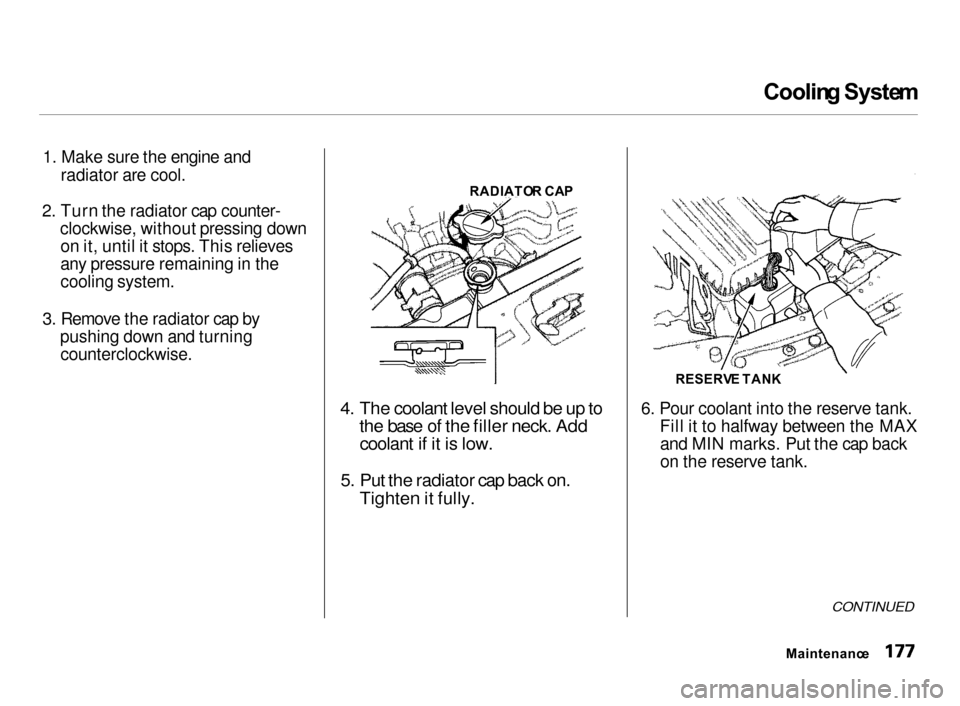
Coolin
g Syste m
1. Make sure the engine and
radiator are cool.
2. Turn the radiator cap counter-
clockwise, without pressing down on it, until it stops. This relieves
any pressure remaining in the
cooling system.
3. Remove the radiator cap by
pushing down and turningcounterclockwise.
4. The coolant level should be up to
the base of the filler neck. Add
coolant if it is low.
5. Put the radiator cap back on.
Tighten it fully.
6. Pour coolant into the reserve tank.
Fill it to halfway between the MAXand MIN marks. Put the cap back
on the reserve tank.
CONTINUED
Maintenanc e
RESERV
E TAN K
RADIATO
R CA P
Page 181 of 279
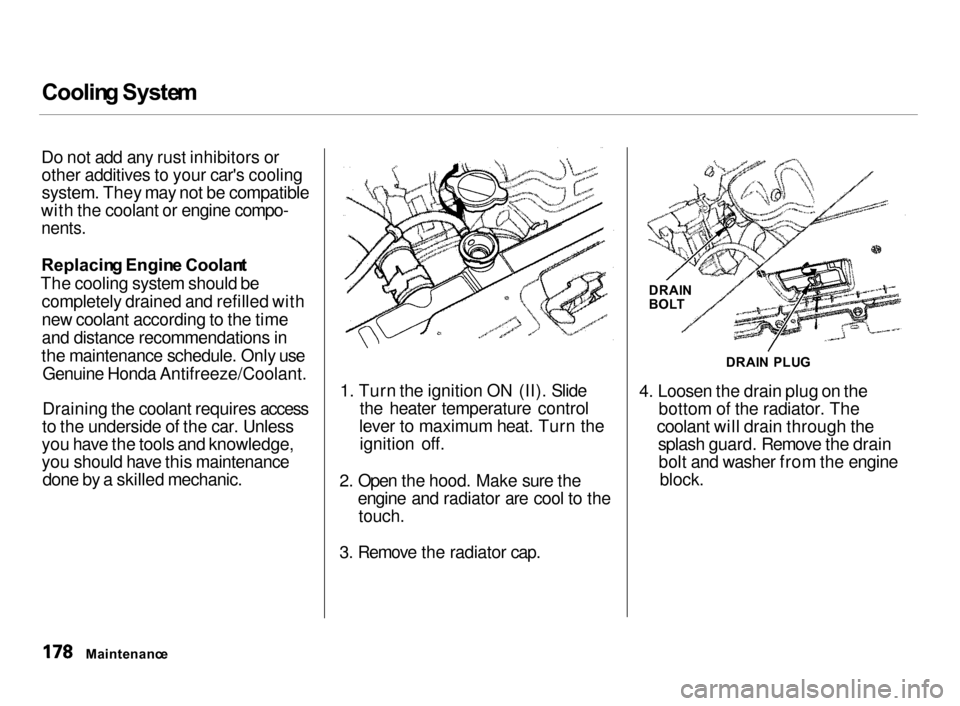
Coolin
g Syste m
Do not add any rust inhibitors or other additives to your car's cooling
system. They may not be compatible
with the coolant or engine compo-
nents.
Replacin g Engin e Coolan t
The cooling system should be completely drained and refilled with
new coolant according to the time
and distance recommendations in
the maintenance schedule. Only use Genuine Honda Antifreeze/Coolant.
Draining the coolant requires access
to the underside of the car. Unless
you have the tools and knowledge,
you should have this maintenance done by a skilled mechanic. 1. Turn the ignition ON (II). Slidethe heater temperature control
lever to maximum heat. Turn the ignition off.
2. Open the hood. Make sure the
engine and radiator are cool to the touch.
3. Remove the radiator cap. 4. Loosen the drain plug on the
bottom of the radiator. The
coolant will drain through the splash guard. Remove the drainbolt and washer from the engine block.
Maintenanc e DRAI
N PLU G
DRAI
N
BOL T
Page 182 of 279
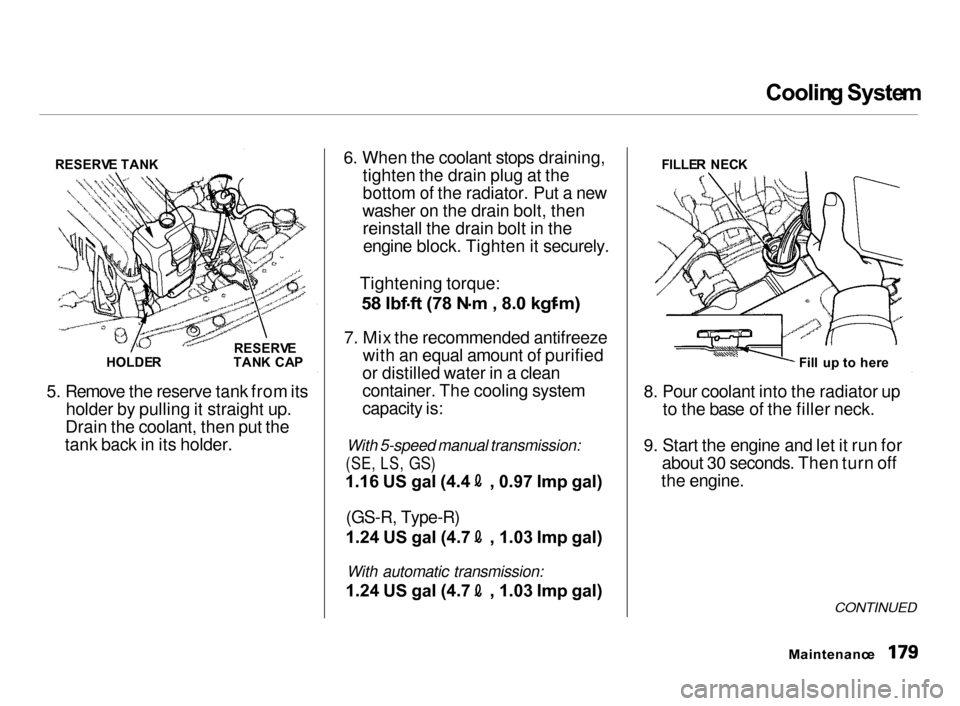
Coolin
g Syste m
5. Remove the reserve tank from itsholder by pulling it straight up.
Drain the coolant, then put the
tank back in its holder.
6. When the coolant stops draining,
tighten the drain plug at the
bottom of the radiator. Put a new
washer on the drain bolt, then reinstall the drain bolt in theengine block. Tighten it securely.
Tightening torque:
58 Ibf .
ft (78 N .
m , 8.0 kgf .
m)
7. Mix the recommended antifreeze
with an equal amount of purified
or distilled water in a clean
container. The cooling system
capacity is:
With 5-speed manual transmission:
(SE,
LS,
GS)
1.16 US gal (4.4 , 0.97 Imp gal)
(GS-R, Type-R)
1.24 US gal (4.7 , 1.03 Imp gal)
With automatic transmission:
1.24 US gal (4.7 , 1.03 Imp gal)
8. Pour coolant into the radiator up
to the base of the filler neck.
9. Start the engine and let it run for
about 30 seconds. Then turn off
the engine.
CONTINUED
Maintenanc e
HOLDE
R RESERV
E
TAN K CA P
RESERV
E TAN K
Fill u p t o her e
FILLE
R NEC K
Page 183 of 279
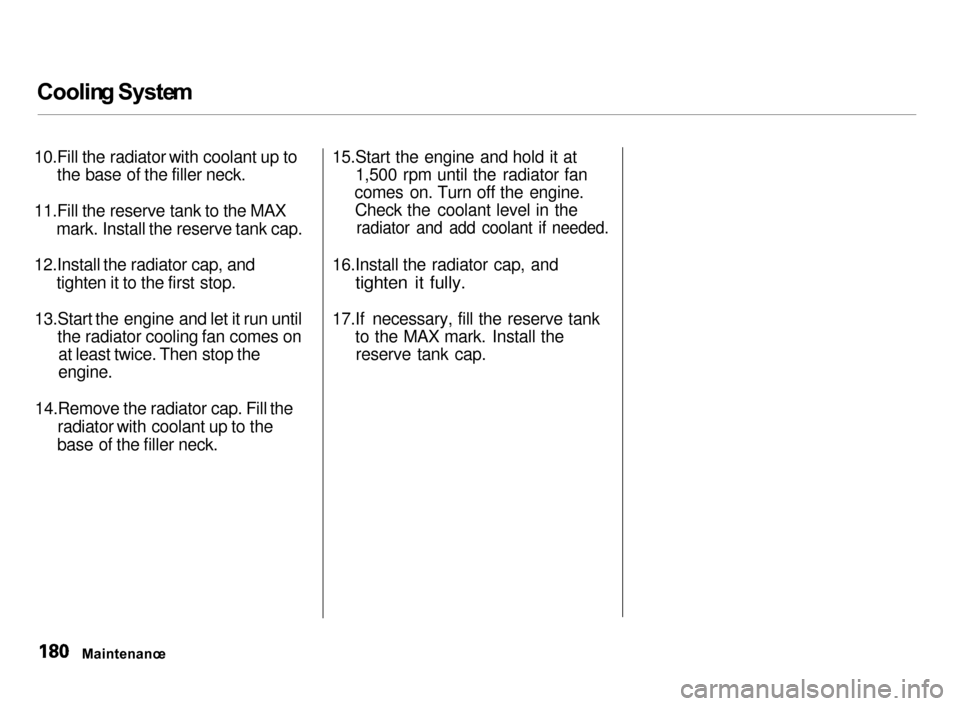
Coolin
g Syste m
10.Fill the radiator with coolant up to
the base of the filler neck.
11.Fill the reserve tank to the MAX
mark. Install the reserve tank cap.
12.Install the radiator cap, and
tighten it to the first stop.
13.Start the engine and let it run until
the radiator cooling fan comes on at least twice. Then stop the
engine.
14.Remove the radiator cap. Fill the
radiator with coolant up to the
base of the filler neck.
15.Start the engine and hold it at
1,500 rpm until the radiator fan
comes on. Turn off the engine. Check the coolant level in the
radiator and add coolant if needed.
16.Install the radiator cap, and
tighten it fully.
17.If necessary, fill the reserve tank
to the MAX mark. Install thereserve tank cap.
Maintenanc e
Page 236 of 279
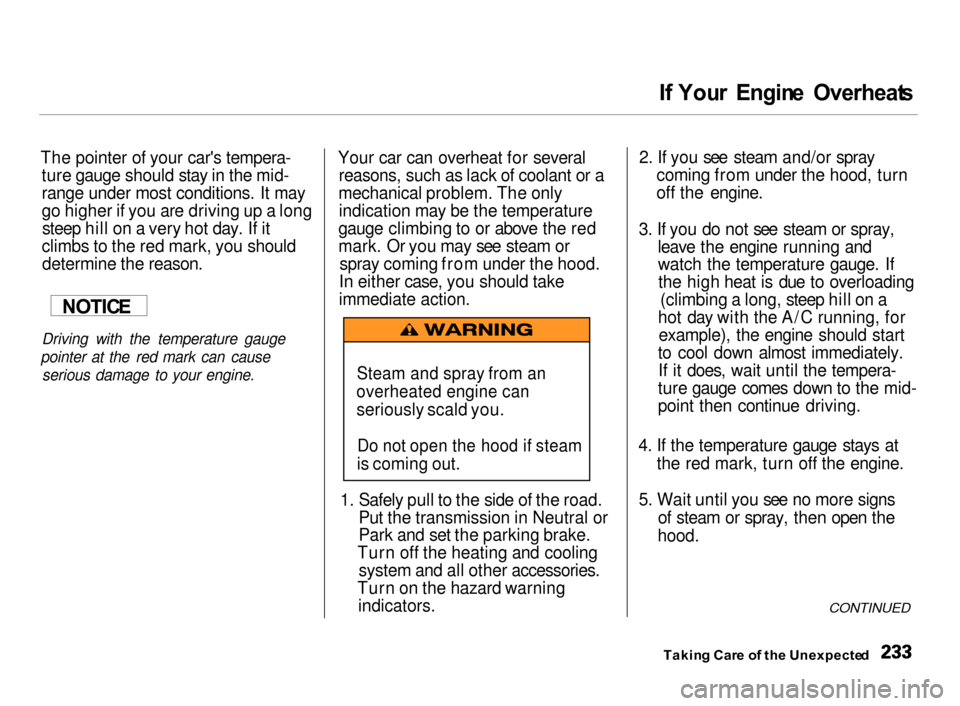
I
f You r Engin e Overheat s
The pointer of your car's tempera- ture gauge should stay in the mid-
range under most conditions. It may
go higher if you are driving up a longsteep hill on a very hot day. If it
climbs to the red mark, you should determine the reason.
Driving with the temperature gauge
pointer at the red mark can cause serious damage to your engine. Your car can overheat for several
reasons, such as lack of coolant or a
mechanical problem. The only indication may be the temperature
gauge climbing to or above the red
mark. Or you may see steam or spray coming from under the hood.
In either case, you should take
immediate action.
1. Safely pull to the side of the road.
Put the transmission in Neutral or
Park and set the parking brake.
Turn off the heating and cooling system and all other accessories.
Turn on the hazard warning indicators.
2. If you see steam and/or spray
coming from under the hood, turn
off the engine.
3. If you do not see steam or spray,
leave the engine running and
watch the temperature gauge. If the high heat is due to overloading (climbing a long, steep hill on a
hot day with the A/C running, for example), the engine should start
to cool down almost immediately. If it does, wait until the tempera-
ture gauge comes down to the mid-
point then continue driving.
4. If the temperature gauge stays at
the red mark, turn off the engine.
5. Wait until you see no more signs
of steam or spray, then open the
hood.
CONTINUED
Takin g Car e o f th e Unexpecte d
NOTIC
E
Steam and spray from an
overheated engine can
seriously scald you.
Do not open the hood if steam
is coming out.
Page 237 of 279
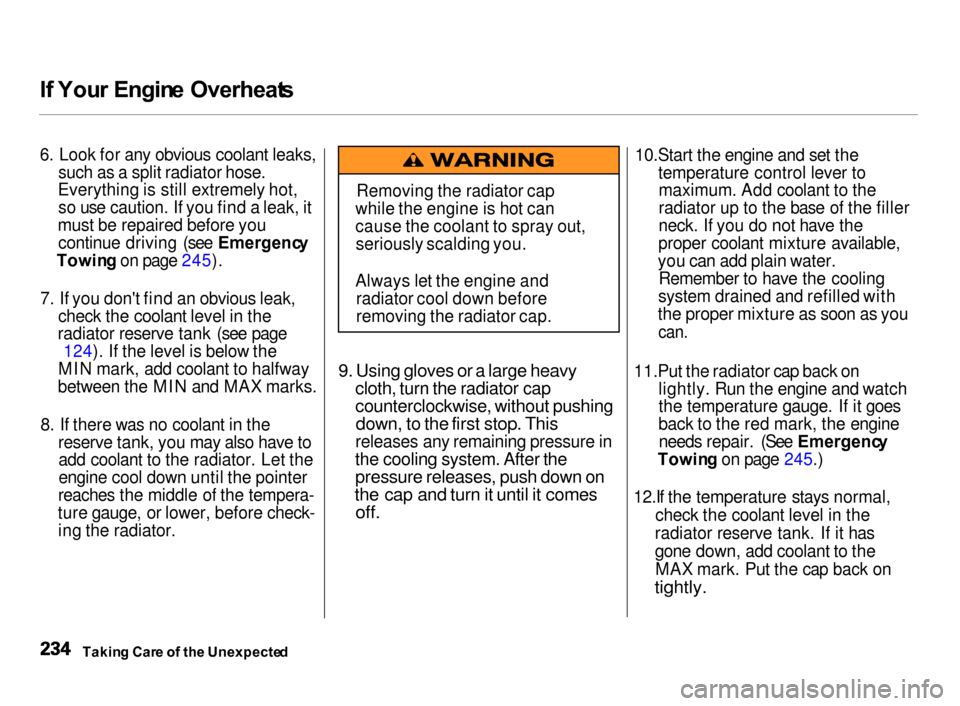
I
f You r Engin e Overheat s
6. Look for any obvious coolant leaks,
such as a split radiator hose.
Everything is still extremely hot, so use caution. If you find a leak, it
must be repaired before you continue driving (see Emergenc y
Towin g on page 245).
7. If you don't find an obvious leak,
check the coolant level in the
radiator reserve tank (see page 124). If the level is below the
MIN mark, add coolant to halfway
between the MIN and MAX marks.
8. If there was no coolant in the
reserve tank, you may also have to add coolant to the radiator. Let the
engine cool down until the pointer
reaches the middle of the tempera-
ture gauge, or lower, before check- ing the radiator.
9. Using gloves or a large heavy
cloth, turn the radiator cap
counterclockwise, without pushing
down, to the first stop. This
releases any remaining pressure in
the cooling system. After the
pressure releases, push down on
the cap and turn it until it comes
off.
10.Start the engine and set the
temperature control lever to
maximum. Add coolant to the
radiator up to the base of the filler
neck. If you do not have the
proper coolant mixture available,
you can add plain water. Remember to have the cooling
system drained and refilled with
the proper mixture as soon as you
can.
11.Put the radiator cap back on
lightly. Run the engine and watch
the temperature gauge. If it goes
back to the red mark, the engine needs repair. (See Emergenc y
Towin g on page 245.)
12.If the temperature stays normal,
check the coolant level in the
radiator reserve tank. If it has
gone down, add coolant to the MAX mark. Put the cap back on
tightly.
Takin g Car e o f th e Unexpecte d
Removing the radiator cap
while the engine is hot can
cause the coolant to spray out, seriously scalding you.
Always let the engine and radiator cool down before
removing the radiator cap.
Page 253 of 279
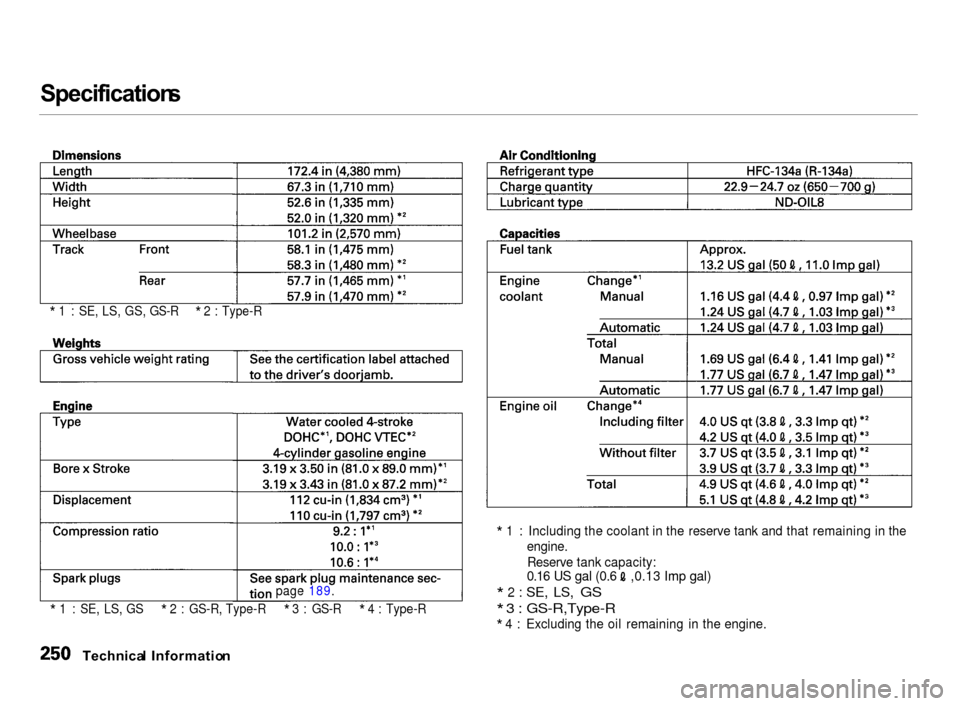
Specification
s
Technica l Informatio n
*
1 : Including the coolant in the reserve tank and that remaining in the
engine.
Reserve tank capacity:0.16 US gal (0.6 ,0.13 Imp gal)
*
2
:
SE, LS,
GS
* 3 : GS-R,Type-R
* 4 : Excluding the oil remaining in the engine.
*
1 : SE, LS, GS, GS-R
* 2 : Type-R
* 1 : SE, LS, GS
* 2 : GS-R, Type-R
* 3 : GS-R
* 4 : Type-R
page 189.
Page 270 of 279
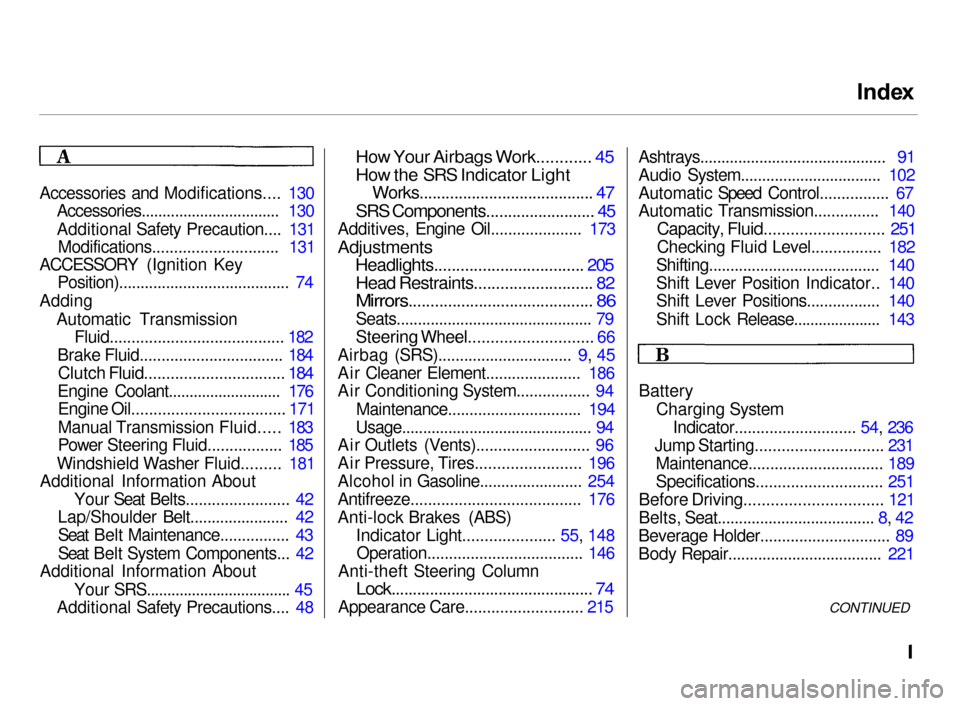
Inde
x
Accessories and Modifications.... 130 Accessories................................. 130
Additional Safety Precaution.... 131Modifications............................. 131
ACCESSORY (Ignition Key Position)........................................ 74
Adding Automatic Transmission Fluid........................................ 182
Brake Fluid................................. 184
Clutch Fluid................................ 184
Engine Coolant........................... 176
Engine Oil................................... 171
Manual Transmission Fluid..... 183
Power Steering Fluid................. 185
Windshield Washer Fluid......... 181
Additional Information About
Your Seat Belts........................ 42
Lap/Shoulder Belt....................... 42
Seat Belt Maintenance................ 43
Seat Belt System Components... 42
Additional Information About
Your SRS................................... 45
Additional Safety Precautions.... 48
How Your Airbags Work............ 45
How the SRS Indicator Light
Works........................................ 47
SRS Components......................... 45
Additives, Engine Oil..................... 173
Adjustments
Headlights.................................. 205
Head Restraints........................... 82
Mirrors.......................................... 86
Seats.............................................. 79
Steering Wheel............................ 66
Airbag (SRS)...............................
9, 45
Air Cleaner Element...................... 186
Air Conditioning System................. 94
Maintenance............................... 194
Usage............................................. 94
Air Outlets (Vents).......................... 96
Air Pressure, Tires........................ 196
Alcohol in Gasoline........................ 254
Antifreeze....................................... 176
Anti-lock Brakes (ABS)
Indicator Light..................... 55, 148Operation.................................... 146
Anti-theft Steering Column
Lock............................................... 74
Appearance Care........................... 215 Ashtrays............................................ 91
Audio System................................. 102
Automatic Speed Control................ 67
Automatic Transmission............... 140
Capacity, Fluid........................... 251
Checking Fluid Level................ 182
Shifting........................................ 140
Shift Lever Position Indicator.. 140
Shift Lever Positions................. 140
Shift Lock Release..................... 143
Battery Charging SystemIndicator............................ 54, 236
Jump Starting............................. 231 Maintenance............................... 189
Specifications............................. 251
Before Driving............................... 121
Belts, Seat..................................... 8, 42
Beverage Holder.............................. 89
Body Repair.................................... 221
CONTINUED
Page 271 of 279
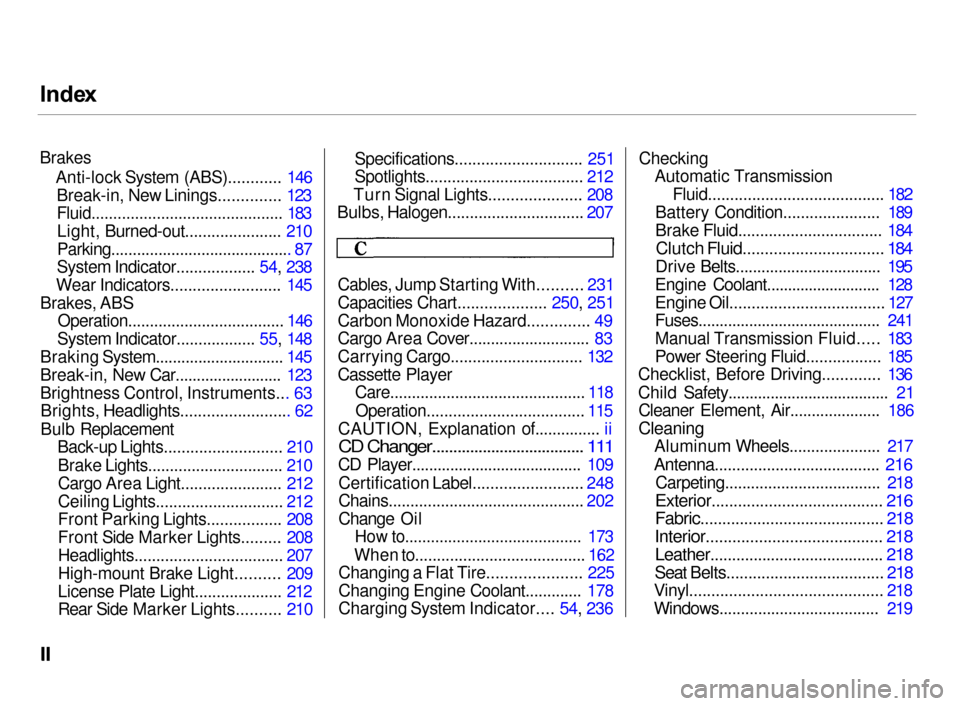
Inde
x
Brakes Anti-lock System (ABS)............ 146Break-in, New Linings.............. 123
Fluid............................................ 183
Light, Burned-out...................... 210
Parking.......................................... 87
System Indicator.................. 54, 238
Wear Indicators......................... 145
Brakes, ABS Operation.................................... 146
System Indicator.................. 55, 148
Braking System.............................. 145
Break-in, New Car......................... 123
Brightness Control, Instruments... 63 Brights, Headlights......................... 62
Bulb Replacement Back-up Lights........................... 210
Brake Lights............................... 210
Cargo Area Light....................... 212
Ceiling Lights............................. 212
Front Parking Lights................. 208
Front Side Marker Lights......... 208
Headlights.................................. 207
High-mount Brake Light.......... 209
License Plate Light.................... 212
Rear Side Marker Lights.......... 210 Specifications............................. 251
Spotlights.................................... 212
Turn Signal Lights..................... 208
Bulbs, Halogen............................... 207
Cables, Jump Starting With.......... 231
Capacities Chart.................... 250, 251
Carbon Monoxide Hazard.............. 49
Cargo Area Cover............................ 83
Carrying Cargo.............................. 132
Cassette Player Care............................................. 118
Operation.................................... 115
CAUTION, Explanation of............... ii
CD Changer.................................... 111
CD Player........................................ 109
Certification Label......................... 248
Chains............................................. 202
Change Oil
How to......................................... 173
When to....................................... 162
Changing a Flat Tire..................... 225
Changing Engine Coolant............. 178
Charging System Indicator.... 54, 236 Checking
Automatic Transmission
Fluid........................................ 182
Battery Condition...................... 189
Brake Fluid................................. 184
Clutch Fluid................................ 184
Drive Belts.................................. 195
Engine Coolant........................... 128
Engine Oil................................... 127
Fuses........................................... 241
Manual Transmission Fluid..... 183
Power Steering Fluid................. 185
Checklist, Before Driving............. 136
Child Safety...................................... 21 Cleaner Element, Air..................... 186
Cleaning
Aluminum Wheels..................... 217
Antenna...................................... 216
Carpeting.................................... 218
Exterior....................................... 216
Fabric.......................................... 218
Interior........................................ 218
Leather........................................ 218
Seat Belts.................................... 218
Vinyl............................................ 218
Windows..................................... 219
Page 272 of 279
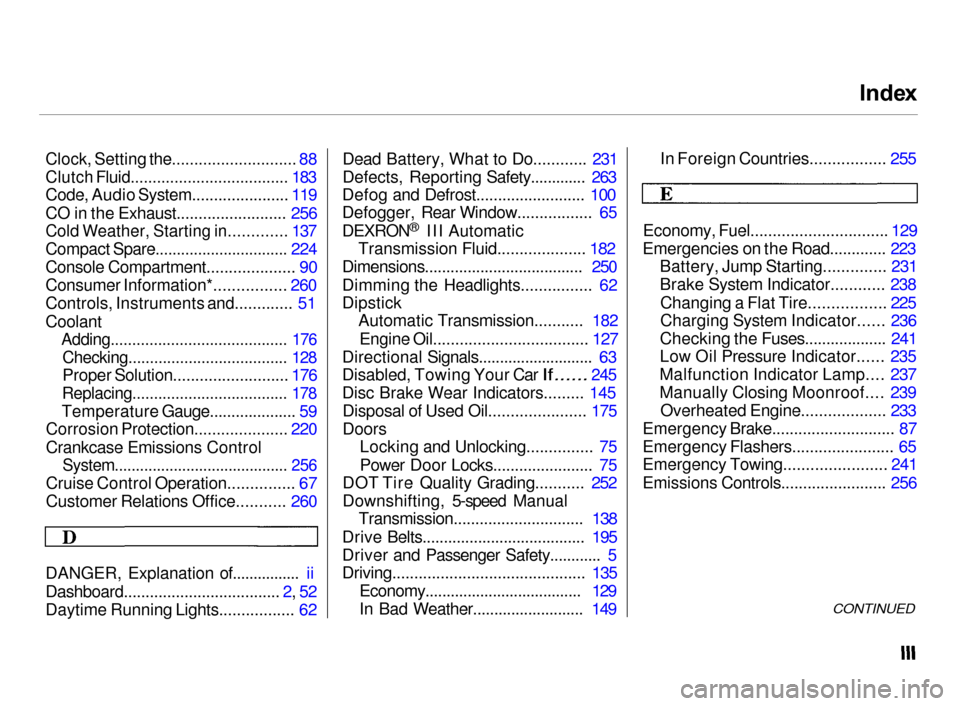
Inde
x
Clock, Setting the............................ 88
Clutch Fluid.................................... 183
Code, Audio System...................... 119
CO in the Exhaust......................... 256
Cold Weather, Starting in............. 137
Compact Spare............................... 224
Console Compartment.................... 90
Consumer Information*................ 260
Controls, Instruments and............. 51
Coolant
Adding......................................... 176
Checking..................................... 128
Proper Solution.......................... 176
Replacing.................................... 178
Temperature Gauge.................... 59
Corrosion Protection..................... 220
Crankcase Emissions Control
System......................................... 256
Cruise Control Operation............... 67
Customer Relations Office........... 260
DANGER, Explanation of................
ii
Dashboard.................................... 2, 52
Daytime Running Lights................. 62 Dead Battery, What to Do............ 231
Defects, Reporting Safety............. 263
Defog and Defrost......................... 100
Defogger, Rear Window................. 65
DEXRON ®
III Automatic
Transmission Fluid.................... 182
Dimensions..................................... 250
Dimming the Headlights................ 62
Dipstick Automatic Transmission........... 182
Engine Oil................................... 127
Directional Signals........................... 63
Disabled, Towing Your Car
If......
245
Disc Brake Wear Indicators......... 145 Disposal of Used Oil...................... 175
Doors Locking and Unlocking............... 75
Power Door Locks....................... 75
DOT Tire Quality Grading........... 252
Downshifting, 5-speed Manual Transmission.............................. 138
Drive Belts...................................... 195
Driver and Passenger Safety............ 5
Driving............................................ 135 Economy..................................... 129
In Bad Weather.......................... 149 In Foreign Countries................. 255
Economy, Fuel............................... 129
Emergencies on the Road............. 223 Battery, Jump Starting.............. 231
Brake System Indicator............ 238
Changing a Flat Tire................. 225
Charging System Indicator...... 236
Checking the Fuses................... 241
Low Oil Pressure Indicator...... 235
Malfunction Indicator Lamp.... 237
Manually Closing Moonroof.... 239 Overheated Engine................... 233
Emergency Brake............................ 87
Emergency Flashers....................... 65
Emergency Towing....................... 241
Emissions Controls........................ 256
CONTINUED